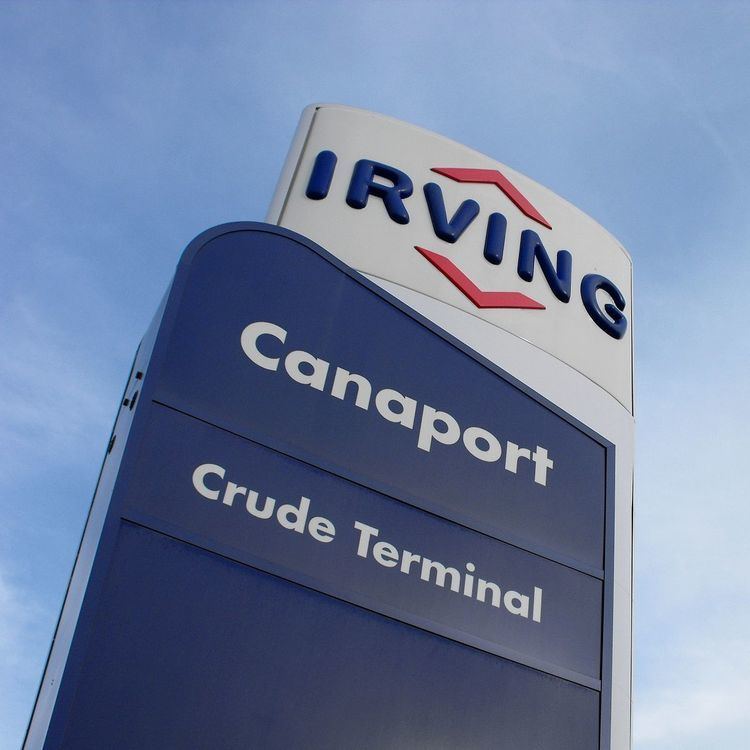 | ||
Opened 1970 (crude oil terminal), 2008 (LNG terminal) Type of harbor deep-water crude oil receiving terminalliquified natural gas terminal Available berths 1 mono-buoy for crude oil supertankers1 jetty for LNG tankers | ||
Canaport lng terminal time lapse hd
Canaport is a Canadian marine crude oil receiving terminal located on the north shore of the Bay of Fundy at Mispec Point, approximately 9 km (5.6 mi) southeast of the city of Saint John, New Brunswick.
Contents
- Canaport lng terminal time lapse hd
- Canaport lng mispec beach saint john new brunswick aerial clips
- Crude terminal infrastructure
- NB Power
- Canaport LNG
- Controversy
- Proposed new oil export terminal
- References
Commissioned in 1970, Canaport was the first deep-water crude terminal in the Western Hemisphere able to receive supertankers. Canaport was built by Irving Oil, which has continuously owned and operated the facility throughout its existence. The terminal is currently configured exclusively as a crude receiving terminal in order to supply the Irving Oil Refinery, which was itself constructed in 1960.
Canaport lng mispec beach saint john new brunswick aerial clips
Crude terminal infrastructure
Canaport consists of the following infrastructure:
The terminal was originally designed to have 5 storage tanks measuring 200 ft (61 m) in diameter. The owner of Irving Oil, K.C. Irving modified the terminal's design to include 6 tanks so each tank could each have a single letter that when combined would spell I-R-V-I-N-G when viewed from the water. Subsequent expansions of the refinery in the 1970s, 80s and 90s resulted in the construction of additional storage tanks.
NB Power
In 1976 NB Power commissioned the Coleson Cove Generating Station which is connected to Canaport by the 20 km (12 mi) Lorneville Pipeline. NB Power receives #6 fuel oil (known as "Bunker C") at Canaport where it is stored in two 1,500,000 bbl (240,000,000 l) tanks before being transported by the pipeline.
Canaport LNG
The Canaport LNG terminal is a liquified natural gas (LNG) receiving and regasification terminal located adjacent and immediately east of the Canaport crude receiving terminal. Commissioned in 2008, it is Canada's first LNG terminal and the first LNG terminal built in eastern North America in 30 years. It is capable of receiving the largest LNG tankers in the world.
Canaport LNG has a nominal capacity of handling 1,200,000,000 cu ft (34,000,000 m3) of LNG per day, enough to heat 5 million homes. Regasified LNG from the Canaport LNG terminal is capable of supplying 20% of the natural gas demand in the northeastern United States and Canada.
In 2001 Irving Oil applied for a permit to add liquified natural gas (LNG) to its Canaport deep-water crude receiving terminal. The permit was granted in April 2004 and Irving Oil entered into a partnership with Repsol S.A. to develop what is now called Canaport LNG; Irving Oil owns 25% of Canaport LNG while Repsol S.A. owns 75%. Construction of the LNG terminal started in September 2005 and the facility was commissioned in 2008 and received its first shipment of LNG in June 2009.
Canaport LNG consists of the following infrastructure:
The construction of the Canaport LNG was coincident with construction of the Brunswick Pipeline which transports the natural gas from Canaport LNG to markets.
Controversy
In 2005, Irving Oil received a controversial tax break from the City of Saint John to develop the Canaport LNG terminal; it was apparently negotiated one-on-one with the city's then-mayor Norm MacFarlane. The tax concessions have cost the City of Saint John approximately $75 million over ten years, with a potential total loss of over $180 million. Saint John Common Council’s reconsideration of this tax concession in 2015 resulted in warnings from Irving Oil, including editorials published in the Telegraph-Journal arguing against re-opening the deal.
Proposed new oil export terminal
Irving Oil has announced plans to build a new $300-million terminal at Canaport to export the oil from the proposed Energy East pipeline.
